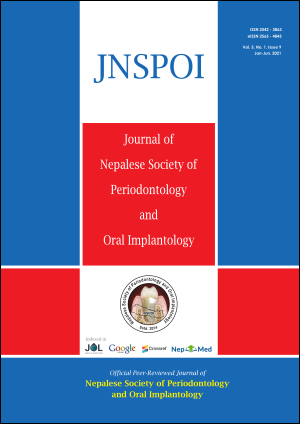Occurrence of Extra Roots in Permanent Mandibular Molars: A Cone Beam Computed Topography Study
DOI:
https://doi.org/10.3126/jnspoi.v5i1.38180Keywords:
Cone beam computed tomography, radix entomolaris, radix paramolarisAbstract
Introduction: Permanent mandibular first and second molars may display extra roots namely radix entomolaris and radix paramolaris which may have implications in endodontic treatment outcome, if missed.
Objective: To evaluate the occurrence of extra roots in permanent mandibular first and second molars in a sample of Nepalese population.
Methods: This analytical cross-sectional study was done at Dhulikhel hospital. Convenience sampling technique was utilised for data collection of 773 CBCT images. Images from June 2018 to June 2020 were retrospectively screened for presence of fully erupted bilateral mandibular first and second molars. Presence of extra roots were recorded and laterality, gender, and racial variations were analysed by Fisher’s exact test and Chi-square test using SPSS v.20.
Results: For mandibular first molars, out of 517 patients, 65 (11.38%) had radix entomolaris: 38 (13.2%) female and 27 (9.54%) male. Among 38 females; occurrence was 21 (7.3%) bilateral, 16 (5.56%) unilateral right and 1 (0.34%) unilateral left side. Likewise, among 27 males, the occurrence was 15 (5.3%) bilateral, 6 (2.1%) unilateral right and 6 (2.1%) unilateral left side. Regarding races, 50 (14.6%) were Mongoloids and 15 (6.6%) were Aryans. No radix paramolaris was found in mandibular first molars. For mandibular second molars, out of 623 patients, radix entomolaris and paramolaris were observed in 0.8% and 0.48% respectively.
Conclusion: The overall occurrence of radix entomolaris in mandibular first and second molars was found to be 11.38% and 0.8%, respectively. Practitioners should be aware of these unusual variations to avoid iatrogenic mishap due to missed canal.
Downloads
Downloads
Published
How to Cite
Issue
Section
License
© Nepalese Society of Periodontology and Oral implantology (NSPOI)
Licenced by Creative Commons Attribution 4.0 International License.




